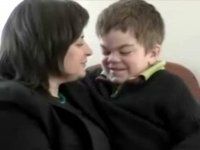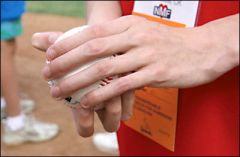![]()
![]()
![]()
Use LEFT and RIGHT arrow keys to navigate between flashcards;
Use UP and DOWN arrow keys to flip the card;
H to show hint;
A reads text to speech;
47 Cards in this Set
- Front
- Back
|
When does ketonuria occur?
|
starvation or insulin deficiency
|
|
|
Klinefelter syndrome
|
1 in 850 males. 47XXY. Sx= oligospermia, bilateral gynecomastia, reduced testicular size, reduced body hair.
|
|
|
47XYY
|
taller than average stature
|
|
|
46XX/47XX+21
|
Milder features of down syndrome
|
|
|
47XX+21
|
Down syndrome
|
|
|
46XY, del(22q11)
|
Congenital defects (palate, face, heart). Sometimes T-cell immunodeficiency.
|
|
|
Hunter Syndrome
|
Lysosomal storage disease w/ alpha-L-iduronidase deficiency. One of the MPS (mucopolysaccharidoses). Glycosaminoglycans accumulate (dermatan sulfate, heparin sulfate, keratin sulfate, condroitan sulfate). X-linked recessive. (All other MPSs are autosomal recessive).
No corneal clouding. |
|
|
McArdle Syndrome
|
Muscle phosphorylase deficiency. Glycogen storage disease. Presents in young adulthood. Glycogen accumulates in skel muscle. Strenous exercise gives muscle cramps and no rise of lactic acid. Myoglobinuria seen in 50% of cases.
|
|
|
Pompe disease
|
Glycogen storage disease. Lysosomal glucosidase (acid maltase) deficiency. Glycogen in heart gives massive cardiomegaly and heary failure w/in 2 years.
|
|
|
Cleft lip has what type of inheritance?
|
Multifactorial
|
|
|
Marfan syndrome inheritance?
|
Autosomal dominant
|
|
|
Tay-sachs disease inheritance?
|
autosomal recessive (lysozomal storage disease)
|
|
|
Erythroblastosis fetalis inheritance?
|
Maternal sensitization against fetal RBCs.
|
|
|
Polycystic kidney disease inheritance?
|
dominant, recessive or sporadic mutations.
|
|
|
Trisomy 13
|
aka Patau syndrome. Sx= microcephaly, cleft lip/palate, six fingers (polydactyly), severe congenital heart malformation.
|
|
|
Downs syndrome
-another name -disease complications |
trisomy 21. Often congenital HD (ventricular septal defect), 10-20x acute leukemia risk. Alzheimers common if reach 40y/o.
|
|
|
Aortic dissection is common in patients with?
|
Marfans syndrome
|
|
|
Trisomy 21 hand features?
|
single palmar flexion crease and single flexion crease on fifth digit
|
|
|
Monosomy X hand features?
|
short fourth metacarpal
|
|
|
trisomy 18 hand features?
|
fingers clenched, digits 2 and 5 overlapping 3 and 4
|
|
|
triploidy hand features?
|
syndactyly of digits 3 and 4.
|
|

|
Turners syndrome
|
|
|
another term for turner syndrome?
|
monosomy X
|
|
|
What is another name for trisomy 18?
|
Edwards syndrome
|
|
|
Trisomy 18 clinical signs
|
* mental retardation/delayed development (100%), high muscle tone, seizures.
* small head (microcephaly), small eyes, wide-set eyes, epicanthal folds, small lower jaw * Congenital heart defects (90% of individuals) such as ventricular septal defect and valve defects * Severe growth retardation, clenched hands with 2nd and 5th fingers on top * Malformations of the digestive tract, the urinary tract, and genitals |
|
|
Fragile X syndrome
- inheritance |
X-linked recessive.
|
|
|
Fragile X syndrome
-gene? |
Trinucleotide repeat disorder (CGG).
Affects methylations and expression of fragile X mental retardation protein 1 (FMRP1). Associated w/ chromo breakage. |
|
|
Fragile X syndrome
-Sx |
Mental retardation, macroorchidism (large testes), speech delay, behavior problems (ADHD), prominent forehead and jaw, joint laxity, large, dysmorphic ears, autism. Fragile X= eXtra large testes, jaw, ears
|
|
|
What is the first and second leading causes of inherited mental retardation?
|
Down's syndrome (#1) and Fragile X
|
|
|
Friedreich ataxia (FRDA)
-inheritance |
autosomal recessive
|
|
|
Friedreich ataxia
-- gene? |
FXN gene on chromo 9q13-a21.1 for the frataxin protein.
Caused by unstable repeats of GAA. ** Highly expanded repeats outside the gene disease ** |
|
|
Friedreich ataxia
--role of altered protein? |
Frataxin protein.
Plays role in respiratory chain complexes I-III, mitochondrial iron content and antioxidation defense. |
|
|
Friedreich ataxia
--Sx |
Degeneration of posterior column and spinocerebellar tracts. Sensory neuron loss in DRG. Limb ataxia. optic nerve atrophy, scoliosis, bladder dysfunction, swallowing dysfunction, pyramidal tract disease, cardiomyopathy and diabetes.
|
|
|
Myotonic Dystrophy Type 1
-- inheritance? |
autosomal dominant. Caused by unstable CTG repeat sequence. on DMPK gene in chromo 19q13.2-q13.3 for myotonin-protein kinase.
|
|
|
Myotonic Dystrophy Type 1
--role of altered protein? |
myotonin-protein kinase= protein.
intercellular conduction and impulse transmission in heart and skeletal muscles. |
|
|
Myotonic Dystrophy Type 1
-Sx |
muscle weakness, wasting myotonia (delayed relaxation after contraction), cataracts, cardiomyopathy w/ conduction defects, mult. endocrinopathies, low IQ/dementia.
|
|
|
Spinocerebellar ataxias
-inheritance |
autosomal dominant. -repeat sequences.
|
|
|
Spinocerebellar ataxias
-Sx |
increasing cerebellar ataxias.
|
|
|
List 4 diseases or syndromes caused by HIGHLY EXPANDED repeats outside the gene
|
Fragile X, Freidrich ataxia, Myotonic dystrophy type 1, Spinocerebellar ataxias (8 and 11)
|
|
|
List 3 diseases or syndromes caused by moderately expanded CAG repeats inside the gene
|
Huntington's disease, spinal and bulbar muscular atrophy, spinocerebellar ataxia type 3.
|
|
|
Describe the pathogenesis of moderately expanded repeats inside the gene
|
CAG repeat (glutamine) undergoes moderate expansions. Long tract of glutamines (polyglutamine tract) is inserted into the protein and causes aggregation.
|
|
|
Spinal and Bulbar Muscular Atrophy
-inheritance? |
X-linked recessive in the coding sequence of AR gene on chromo Xq11-q12 for androgen receptor; likely gain of function mutation.
|
|
|
Spinal and Bulbar Muscular Atrophy
-Sx |
progressive anterior motor neuron loss, proximal muscle weakness, muscle atrophy, muscle fasciculations, difficulty swalling and speech articulation, late-onset gynecomastia, defective speramtogenesis w/ reduced fertility, testicular atrophy and hormonal profile consistent w/ androgen resistance.
|
|
|
Spinocerebellar ataxia type 3
-Inheritance |
Autosomal dominant w/ CAG (glutamine) repeat in coding sequence of ATXN3 gene fror ataxin 3 protein which is a ubiquitin-specific protease that binds and cleaves ubiquitin chains (thus acts as protein quality control). Thus SCA3 thought to be caused by impaired protein clearance.
|
|
|
Spinocerebellar ataxia type 3
-Sx |
progressie cerebellar ataxia, dysarthria, bulbar dysfunction, extrapyramidal features (rigidity, dystonia), upper/lower neuron signs, cognitive impairments. onset= 20-50y/o.
nuclear inclusions seen. |
|
|
Marfan's Syndrome
-Mutation, type of disease -Sx |
fibrillin gene mutation.
connective tissue disorder affecting skeleton, heart and eyes. Sx= tall, long extremities, pectus excavatum, lax joints, long tapering fingers and toes, aortic dissection, floppy mitral valve, lens subluxation. |
|

|
marfan's syndrome
fibrillin gene mutation (CT disorder). affects skeleton, heart and eyes. |

